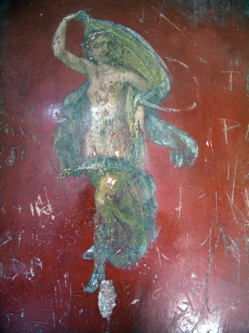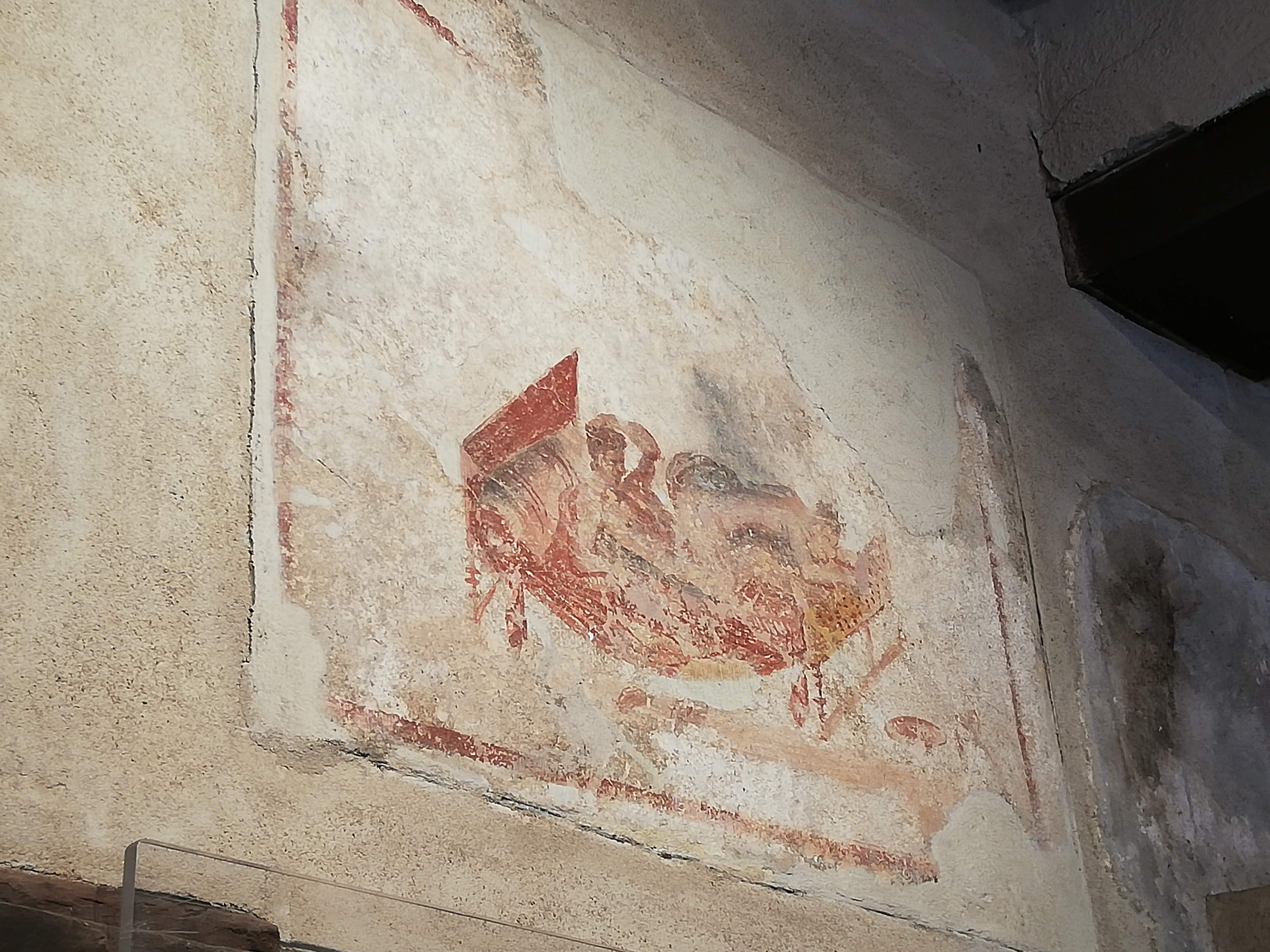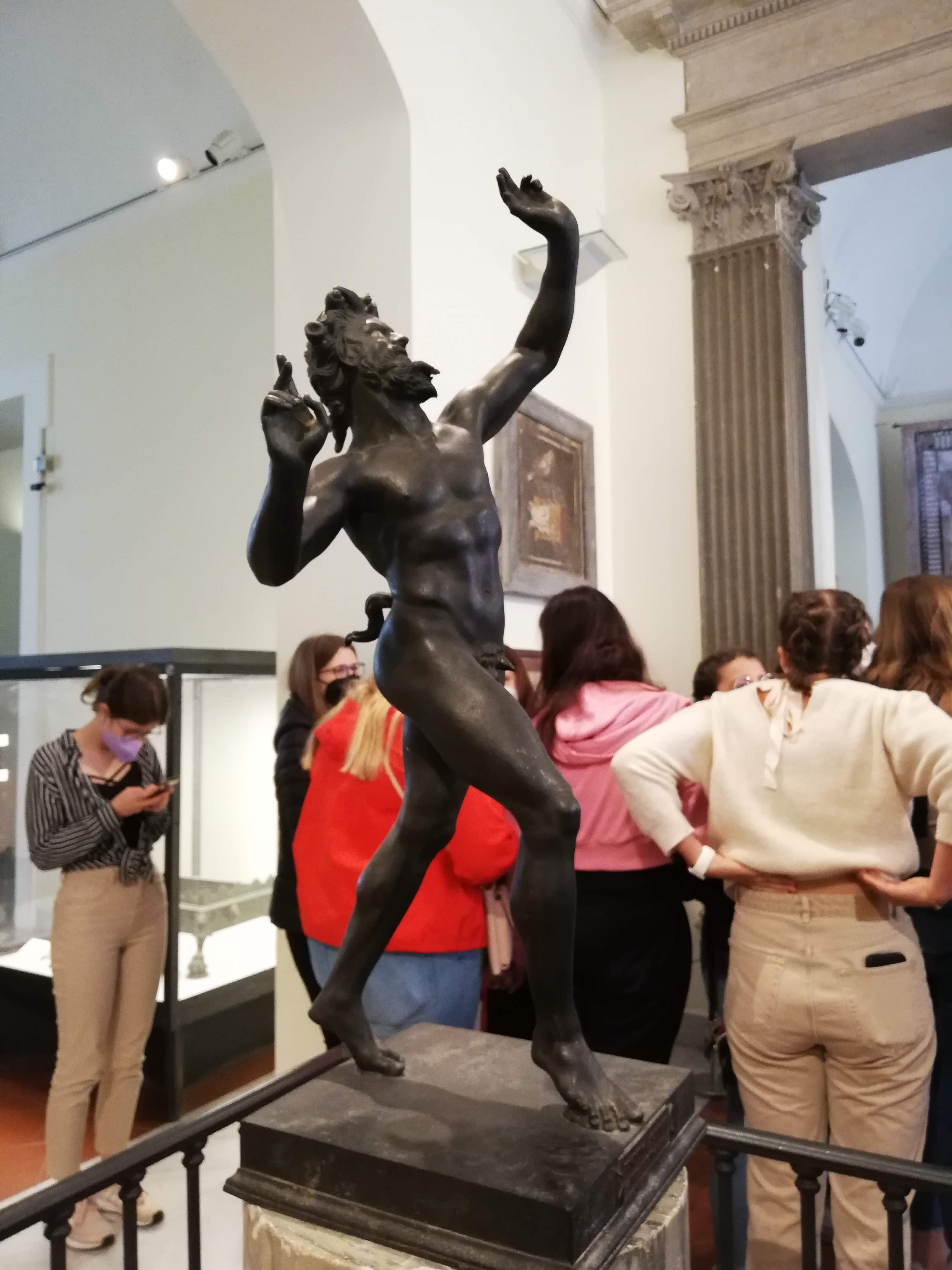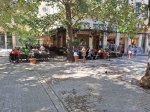Pompeii Art -
Art of the Ancient City Pompeii
"Pompeii Art – Learn about mosaics, frescos and sculpture in Pompeii home ruins, hidden from the world after the Vesuvius Volcano eruption..."
Besides showing us what everyday life of the ancient Romans was in the 1st Ct AD, the ancient city Pompeii is also famous for Pompeii art and being one of the best sites to explore the art of Roman times in general.
The lost city of Pompeii was where wealthy traders, ship captains, and bankers lived.
Just outside the walls of Pompeii and around Herculaneum was where elite Romans built their lavish seaside homes following the example of Julius Caesar and the emperors Nero, Claudius and Caligula who owned houses in the nearby Baiae. August and Tiberius had villas in Capri Italy while Cicero, Virgil and Pliny had residences in the bay area too.
Two millennia ago, Pompeii was something like what the Hamptons are today for New Yorkers.
In their Pompeii retreats, the wealthy crowds could relax away from the bustle of the big city. But one thing they could not leave behind was their sophisticated taste and the need to be surrounded with luxury.
Even though most of the Pompeii art has been moved to the Naples Archaeological Museum, as you walk through Pompeii ruins and Pompeii homes today, you can get a nice surprise round every corner: a flash of the famous Pompeii red here, a wall covered with a beautiful Pompeii fresco there, your feet walking over black and white Pompeii mosaics…
It’s interesting to note, that Romans of good taste were big fans of Greek art and culture… and it really showed in Pompeii art. When Pompeii citizens commissioned art, they often asked for artwork inspired by Greek antiquities: frescoes showing scenes from Greek literature and mythology, portraits of Greek poets, playwrights and philosophers, marble statues that emulated Greek art of the Hellenistic era…
|
Even what’s left over of Pompeii art will delight you, let alone imagining what it must have been like 2000 years ago when these Pompeii homes were full of fine artefacts, bronze statues, silver tableware, fine glass, ceramics, deities figurines… It seemed at first that all these wonders of Pompeii art were ‘lost’ from humanity for nearly 1700 years after the catastrophic Vesuvius Volcano eruption. But today we know that the layers of volcanic ash and pumice stones, instead of destroying it all, actually kept everything intact and protected for many centuries. That’s why today we can learn and enjoy a lot about Pompeii art through looking at… |
If you prefer getting up close and personal with all the artwork that once adorned this fascinating city and its houses, seeing the National Archaeological Museum of Naples is a must! However, keep in mind you are not the only one and the ticket line can be winding all the way out to the street. That's why buying a skip-the-line ticket online is a must! |
Pompeii Fresco Art
The lost city of Pompeii is one of the few precious sources of what we know about ancient painting and decoration. Namely, the Roman civilization has not provided a lot of fresco paintings since they are more subject to damage than sculpture or architecture.
You can find out more about it in our article Pompeii Fresco Paintings.
Pompeii Art: Pompeii Mosaics
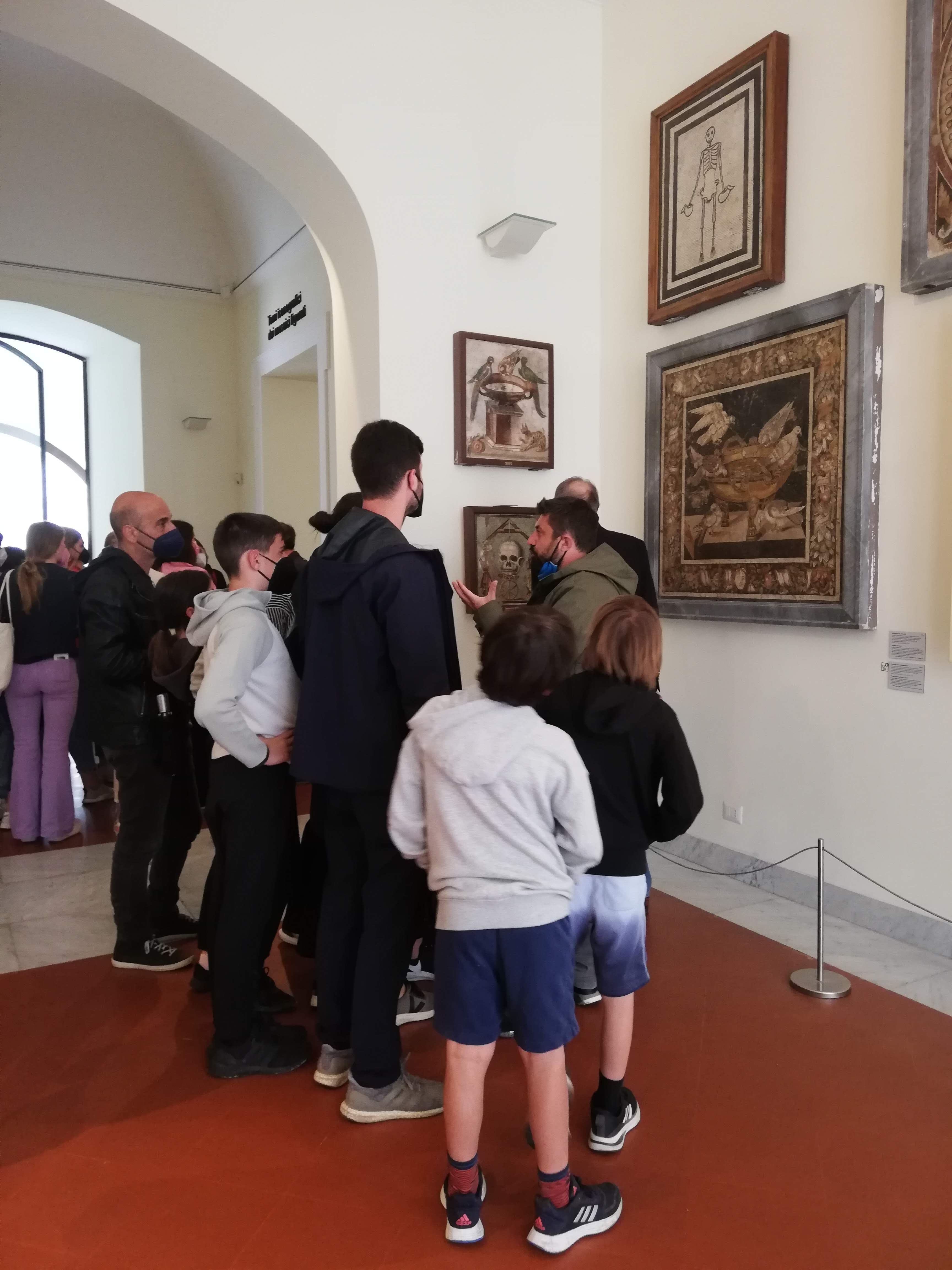 National Archaeological Museum of Naples - having a tour guide by your side is always a great investment!
National Archaeological Museum of Naples - having a tour guide by your side is always a great investment!Some of the most amazing Roman mosaics come from Pompeii.
Although made around 2,000 years ago, they are still in pretty good shape because they got buried under volcanic ash when Mount Vesuvius erupted in 79 CE.
They used tiny pieces of colored stones, glass, and clay called tesserae to make them.
They didn't just make them look pretty; these mosaics told stories from mythology, showed scenes from daily life, and even featured Roman gods.
One famous mosaic, called the "Alexander Mosaic," shows a big battle with Alexander the Great, now displayed in the National Archeology Museum of Naples.
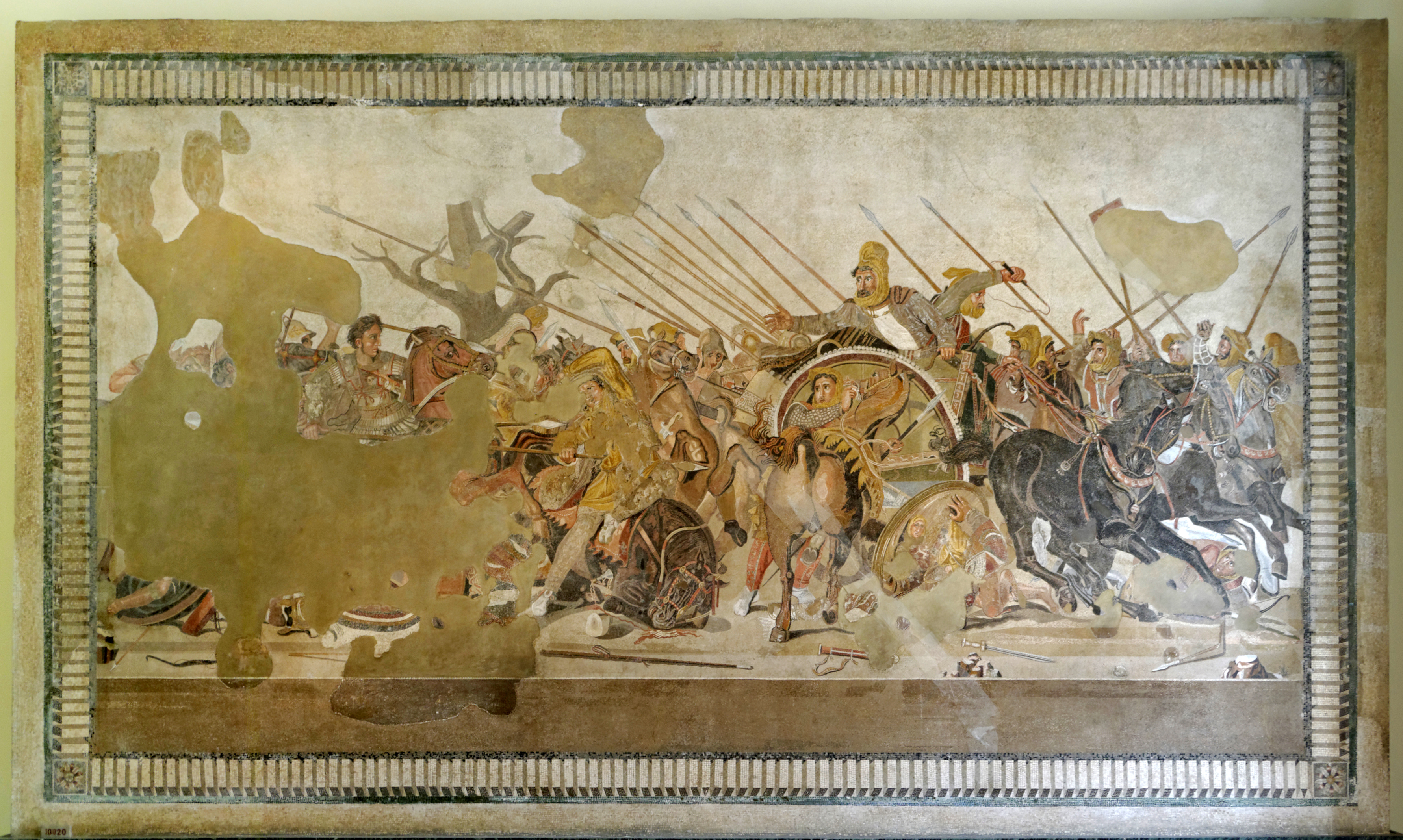
The Alexander Mosaic, in particular, is a masterpiece of ancient mosaic artistry, known for its exceptional level of detail and the skill of the mosaicists who created it. It remains one of the most iconic examples of ancient Roman mosaic work, providing a glimpse into the artistic and historical achievements of the time.
It depicts a vivid and intricate scene of the Battle of Issus, where Alexander the Great triumphed over the Persian King Darius III. The mosaic captures the intense drama of the battle, with Alexander on horseback at the center, engaging Darius in combat.
It can be seen in the National Archaeology Museum of Naples.
Another famous Pompeii mosaic, the "Cave Canem" mosaic, has a picture of a dog and a warning to watch out – kind of like our "Beware of Dog" signs today. It is located on the floor of the entrance hall to the House of the Tragic Poet, inside the site of Pompeii.
These mosaics weren't just on floors; they decorated walls and ceilings too.
They're like windows into the past, giving us a glimpse of what life was like back then. You can see some of them in a museum in Naples or go check them out inside the archeology site of Pompeii. It's like time travel through art!
Not sure how to get from Naples cruise port to Pompeii?
Here are some transport options for you:
Pompeii Art: Pompeii Sculpture
Many a Pompeii home’s rooms, peristyle gardens, atria and fountains were decorated with statues. And so were the open squares and public buildings.
Those sculptures from Pompeii that did survive the Pompeii destruction, show us that statues of a small size were preferred in Pompeii.
Large statues, those of the commemorative type, decorated the Pompeii Forum.
When people of Pompeii walked their main square, on both sides they could see statues of the emperors and the imperial family as well as the worthy citizens of Pompeii from both the past and their times.
There were some commemorative statues also placed in the Forum Triangulare, in the portico of Macellum, portico of Eumachia as well as the sanctuary of the City Lares.
Many Pompeii homes were decorated with sculptured portraits of their owners and family members but also heads and busts of famous men of the past: poets, philosophers and statesmen.
Some of the most noted Pompeii sculpture pieces you can see in the Archaeological Museum of Naples today are:
- The bronze statue of Apollo – Apollo the Archer, originally located in the temple of Apollo in Pompeii.
- The bronze statue of Artemis – also originally located in the temple of Apollo; only the upper part of the statue survived. This statue matches the pose of Apollo, they must have been created as a pair.
- The dancing Satyr – a bronze statue found in the House of the Faun, originally located in its impluvium or the basin catching the rainwater.
Of course, it would be ideal to see both the archeological site of Pompeii and the National Archeology Museum in Naples in a day, to get a complete picture of that time.
And I have found tour that enable you to do just that:
From POMPEII ART to Mediterranean Cruise Ports Easy
HOME PAGE
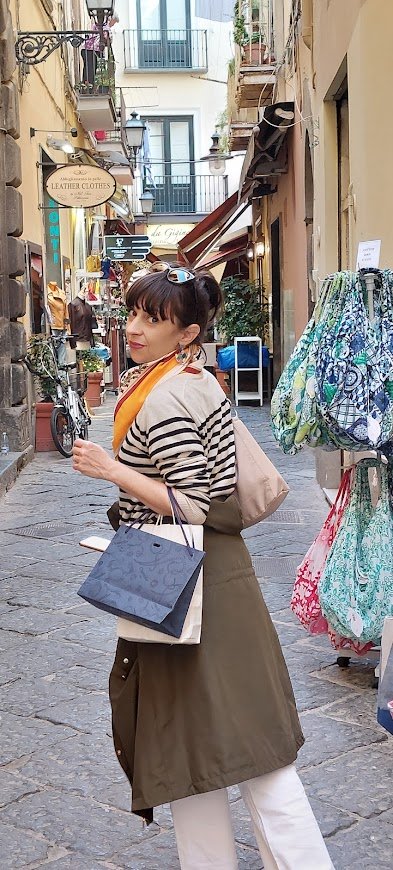
With over seven years working aboard cruise ships as a port guide and shopper assistant, I’ve helped thousands of passengers get the best from their days ashore in Dubrovnik. Now, I want to make you Med confident!
TAKE A SHORTCUT TO TOP 30 MOST VIEWED PAGES OF 2025:
4. Capri ferry
10. Livorno Italy
13. Naples to Capri
16. Messina Sicily
17. Pisa Train
18. Visiting Pompeii
19. Pompeii forum
20. Port of Piraeus
22. Venice vaporetto
23. Venice water bus
24. Livorno map
25. Getting to Zadar
27. Walk Venice
28. Mykonos beach
29. Lucca Italy
30. Pomepii homes
